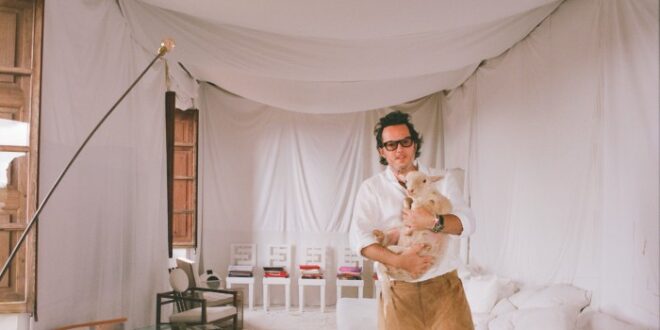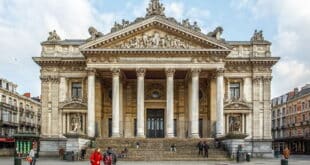Artist, artistic director and architect Alexandre de Betak first started travelling to Mallorca in his 20s, irresistibly drawn to the island’s rugged shoreline and remote mountaintop villages. The unhurried existence of the locale provided a counterpoint to the frenetic pace of life as fashion’s consummate showman – which saw de Betak conjure catwalk spectacles, exhibitions and events, and design lighting and furniture for everyone from Raf Simons to John Galliano. De Betak worked with designers to make their visions come to life, and until recently, he would choreograph the lighting and music, and design, direct, and produce fashion shows. When Simon Porte Jacquemus took over the Palace of Versailles – or a Provençal lavender field – to show his collection, it was de Betak who made it happen.


It was de Betak’s earliest client, the Spanish fashion designer Sybilla, who introduced him to the Balearics, and in 2008 he set about designing and building an otherworldly FlintstonesThe north-west coast is home to a number of properties with a Mediterranean-style. He says, “I was hooked” by the experience. This led him and his wife Sofia Sanchez de Betak to embark on a new chapter in island life. After selling a major stake in Bureau Betak (the company he co-founded in Paris in 1989) to a group in which he is creative chair, he has turned his focus away from live productions and towards interior architecture and designing. Takbe Studio is his company with offices in Paris. It draws inspiration from his highly conceptual and creative approach. De Betak has produced over 1,500 shows. It is a dramatic change in pace, even though the company started out low-key. “I decided to quite drastically change from one life to another,” he says of his career pivot, which is driven, to some degree, by a desire to create something more permanent and environmentally aware, as well as a more harmonious life balance. “I’m very happy to be working on things that last longer than the few minutes of a fashion show.” Not your average interior designer, he says: “I love doing houses. But I work for others as though it’s for myself, I don’t compromise.” Not that it’s deterred the handful of high-end (anonymous) clients who have already hired him.
Each of de Betak’s interiors projects – whether a 17th-century hôtel particulier in Paris or a stripped-back SoHo loft – has been radically different. No exception was made in his latest project, a simple renovation of a mid-18th century finca with four bedrooms, located at the foothills Tramuntana Mountains, where he spends some time with Sofia and Sakura, their six-year old daughter. (De Betak also has two sons, Amaël and Aidyn.) Though secluded – there is little around but ancient olive groves and grazing sheep – it’s accessible; Palma is 30km to the south. “We’d been looking for a project that’s something different for a while,” says the peripatetic designer. I’m always looking for untouched places but it’s hard to find one. Mallorca is full of old farmhouses. But many have been modernised, overly polished or simply aren’t for sale.
After a long search, Sofia spotted this rare gem – raw and unrefined with a timeworn limestone façade – while out driving. Once they had met the owner, an elderly woman whose father had spent time restoring the place during the 1930s and who had no family to pass it on to, it was theirs. It was built for both animals and agriculture, and the top and ground floors were dedicated to grain storage. This is typical of rural dwellings. It was exactly the kind of crumbling, uninhabited look that Betak loves. The walls were cracked and the plumbing was minimal. (Water still comes from a well). But, Betak says, “we liked it just as it is”.


De Betak wanted to create a temporary solution for the interior, in part to avoid the long process of obtaining permissions. He is a “light freak” and wanted to sort out the electrical system in order to illuminate the interior better. He prefers to work in one go, rather than in stages. This includes everything from the furniture he’ll source from his archive to the design, construction, and even the cutlery. His vision for the finca was enacted to the extreme: to dress almost the entire interior – walls, ceilings, windows, upholstery and detailing – in pure white antique “marriage” linen from the 19th and 20th century. “These old fincas are beautiful but I wanted to warm it up,” says de Betak, who collected hundreds of sheets (half from the local market, half from Marché Vernaison in Saint-Ouen), then worked on the elevations, carefully measuring the space before commissioning a local seamstress to stitch each sheet together piece by piece, like an enormous textile puzzle.
A series of rooms, guided by both necessity and playful design, are conceptual, yet womblike, relaxing and comfortable. “It’s like camping but not camping,” he says of the transitory, yet transportive, atmosphere. Dog clips and hooks are used to hang the linen skin, which dresses the interior. Its fabric drapes cleverly conceal a multitude of sins – and enabled de Betak to swiftly rework the plumbing and electrics without ever touching the surface of the walls.



All the bedrooms, including Sakura’s cherry-blossom room, have been given a chic textile treatment. The painted floor is layered with milky-white Turkish Carpets from Istanbul. Sarfatti chair by Marcello Piacentini at the far end is filled with books on Madeleine Castaing, James Turrell and many others. Even the once black bungee cords on the René Herbst tubular metal Sandows dining chairs from 1928 have been customised with white elastic cords. De Betak explains that she designs in a “childlike” way. “I want places that are fun, lively and relaxing.” Under the linen, LED lights softly light the room at night. Along the length of the wall, a wide, pillowy modular daybed he created is also hidden. “It’s more than just preservation,” he explains. “I enjoy things evolving.”
The living room is a jumble of odd objects and furniture; it’s a turn of the century Fortuny A Frank West light from 1990s, a retro-futuristic lamp Elipson The speakers are a Boalum light circa 1970s. Artemide. The dining room table features a pair large, bell-shaped, light shades that are covered in dried leaves. Paul Bert Serpette A flea market is held in Paris. De Betak is more concerned with the balance than the provenance of objects. Making memorable spaces for him is all about creating a certain feeling, similar to a fashion event. The intention was to create a minimalist style that is both visually inspiring and restful. Wonder is the dominant emotion. He says, “It proves that you can have a beautiful historic house and inhabit it in a natural way.”



The atrium is a different story. The atrium, a lacquered black box with high-gloss varnish yacht paint on the floor. The only originals are the mustard-yellow frames on the doors and the 1980s disco light stacks (a throwback from his teenage days when he arranged lights and music for “BoumThe alien atmosphere is punctuated by “parties”.
De Betak’s mastery of atmospheric environments is the reason there is such a similarity between creating a catwalk (even if it is short-lived), and building homes for clients. He says that the pace of the renovation of the showspace was too fast and he has now deliberately slowed it down. He says “I don’t want to label it temporary” as he ponders where the space falls on the scale of ephemerality versus permanence. It’s like a sanctuary.


For de Betak, this more fluid way of designing interiors offers him freedom – one that reaches its apex in the attic: a den-like hideaway. Its exposed wooden beams and bamboo ceiling with its chalky floors, which look out to a shaded pine tree canopy that is perfect for picnics are a part desert encampment and part celestial cavern. It is in this stripped-back interior, however, that de Betak engages occasionally in his own creative thinking. The blank space is like a page.
 Costa News Spain Breaking News | English News in Spain.
Costa News Spain Breaking News | English News in Spain.







